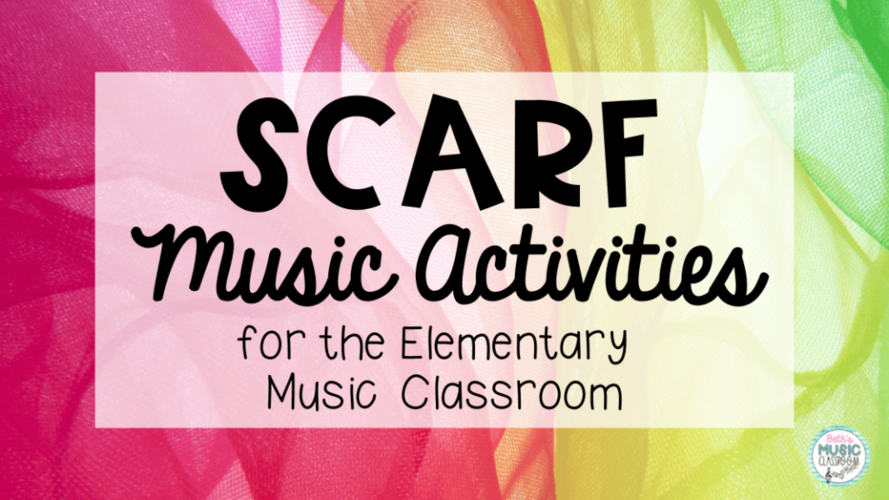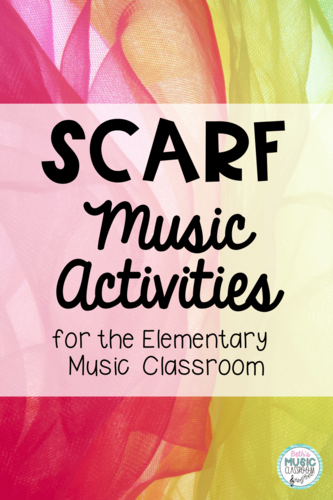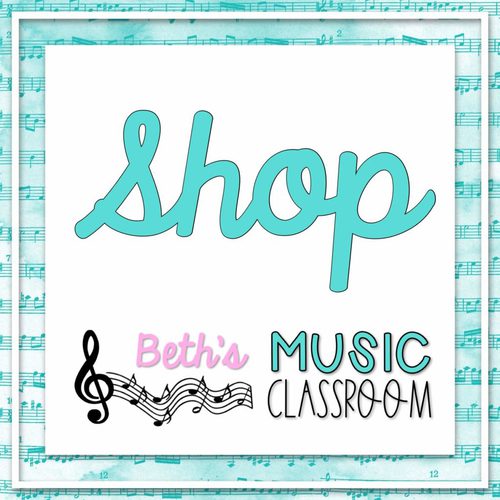This post may contain affiliate links, where I may receive a small commission if you purchase something through following the link at no cost to you.
Scarf Music Activities

Scarf Music Activities
Do you use scarves in your elementary music class? In this post, we’re talking all about why you should use them and some different scarf music activities that work so well in the elementary music room. My students and I had a lot of fun with scarves during social distancing and when teaching on a cart. And now, I still love using them with all types of activities.
Benefits & Tips for Using Scarves in Music
To start with, if you do not have a set of scarves for your class, add it to your wish list. But no worries. You can use any type of lightweight fabric and cut it into squares around 16-28″ wide. You could also use strips of extra large construction paper. During virtual learning, I encouraged students to go find a dish rag or sock. I believe the price of scarves have gone down quite a bit over the past years. If you’re interested in purchasing a set, I would recommend getting a set with a large variety of colors in it and have enough for everyone in your class.
Now, let’s look at some benefits from using scarves in music class. For one thing, I know my students are more engaged when they have something in their hand. Scarves are entertaining, exciting, and allow for musical expression and creative movement.
When planning activities, I always have a time where the class must watch and mirror my body and scarf, matching the style of a musical piece played. This helps them understand the musical elements they hear – legato or staccato, fast or slow, etc.
Also, I add some “freestyle” scarf movements. I tell my students to match their scarf to the music and how it makes them feel. No other explanation is really needed, because even at a young age, they know to move slowly and gracefully when they hear a lullaby or stomp loudly during a march. They are learning how to express their body based on what they hear. Before we begin, I do let them know if they should be using locomotor or non-locomotor movement, as this is important for safety.
Often during this “freestyle” scarf time, I will play the piano, so that I can incorporate lots of different expressional elements:
- Tempo: fast vs. slow
- Dynamics: loud vs. soft
- Expression: legato vs. staccato; phrasing
- Meter: strong vs. weak
- Form: same vs. different
- Melodic Contour: high vs. low; upward vs. downward
With my kindergarten and first grade students, I would not use terms like presto, fortissimo, legato, or rondo. However, I am using creative movement with scarves to help them experience and to prepare them to learn these in the future.
To get you and your students thinking about a whole bunch of ways they could move their scarf and body with it, brainstorm a list.
- Position: sitting, standing, or moving; holding, throwing, or dropping
- Direction: up-down, side-side, or diagonal
- Speed: slow, medium, or fast
- Movement: crisp, smooth, zig-zag, curvy, etc.
- Mood: happy, sad, scary, etc.
Also, don’t be afraid to make up the motions. In the past, I spent a lot time before class, creating a whole routine to accompany a certain piece. Other times, I just make it up on the spot – like when class was extended for 20 extra minutes because of a disturbance in the lobby. I quickly pulled up a composer piece we had listened to last week, passed out scarves, and let my ears tell me how to move my scarf for the students to copy. Or maybe let students take a turn being the mirror.
Adding Scarves to Composer Pieces
Now let’s dive into some specific scarf activities.
To begin, composer listening lessons are just wonderful for adding scarves. As the perfect movement and brain break from sitting and listening, I add them into 1-2 pieces that are in that lesson. Here are just a few of my favorite composer pieces that work really well when adding scarves:
- Minuet in G Major – J.S. Bach (melodic contour and form)
- Eine Kleine Nachtmusik – Mozart (expression and phrasing)
- Aviary, The Carnival of the Animals – Camille Saint-Saëns (fluttering movement)
- Minute Waltz – Chopin (form and movement)
- Symphony No. 5 – Beethoven (expression and mood)
- Hallelujah Chorus – Handel (listening – raise scarf each time they hear the word “Hallelujah”
You could incorporate scarves for any piece in a composer lesson. It may be beneficial to just help students move to a steady beat and to follow the teacher. Even through that, they are still experiencing and moving to music.
Adding Scarves to Children’s Songs
You can also add creative movement into seasonal or fun kid songs that you use each year. For example, I love using the song “Orange, Yellow, and Red,” from Music K-8. I first play it once for students to listen and count the number of colors they hear – 6. Then I use scarves matching those 6 colors. When students hear their color called, they wave their scarf up and down. I have also added some other motions too, and you can read more about it by clicking here. You can check out this blog post for more information on how I use it
Another song from Music K-8 that I use is “Green, Green, Green.” Using scarves, anyone with a green scarf raises theirs up only on the word green during the A section. The other colors move and match the lyrics in the B section. This gets them listening for not only the text, but also recognizing the different sections.
Here’s a great song for creative movement with your young students. The Scarf Dance is a perfect beginner’s song because the lyrics tell you exactly what to do with your scarf. Here’s a video performance of it:
Here’s a few more scarf music activities that I know your kids will enjoy:
- ABC (Jackson 5) by Rhythm Recess
- Walking on Sunshine (Katrina and the Waves) by Rhythm Recess
- Encanto Themed Scarf Movement by Music with Mrs. Thrift
- Best Day of My Life (American Authors) by Ms. Henry
What other scarf songs or pieces do you use with your students? I’d love to hear about them! Leave a comment or connect with me on Instagram @bethsmusicclassroom.

Scarf Music Activities


Hi Beth, curious how you store your scarves?
I keep all my scarves in a large crate on a cubby shelf in my classroom. How do you have yours? They’re tricky to store.
I don’t have one yet, but I’ve seen other teachers keep them stored in a plastic bag holder/dispenser- kids can pull one out the bottom and then they can’t fight over picking a color!
Oh, I love that! I may try using a bag dispenser. Thanks for sharing!
I recently bought mesh laundry bags. I got a medium sized one that can store at least 50-60 scarves. It makes washing them real easy too!
Oh, that’s a great idea – definitely saves time! Thanks for sharing this tip!
I keep them in a big reinforced zip lock bag. they stay clean but it doesn’t matter if they get squashed if you have to move from place to place.
That’s a great idea! They probably take up less space too.